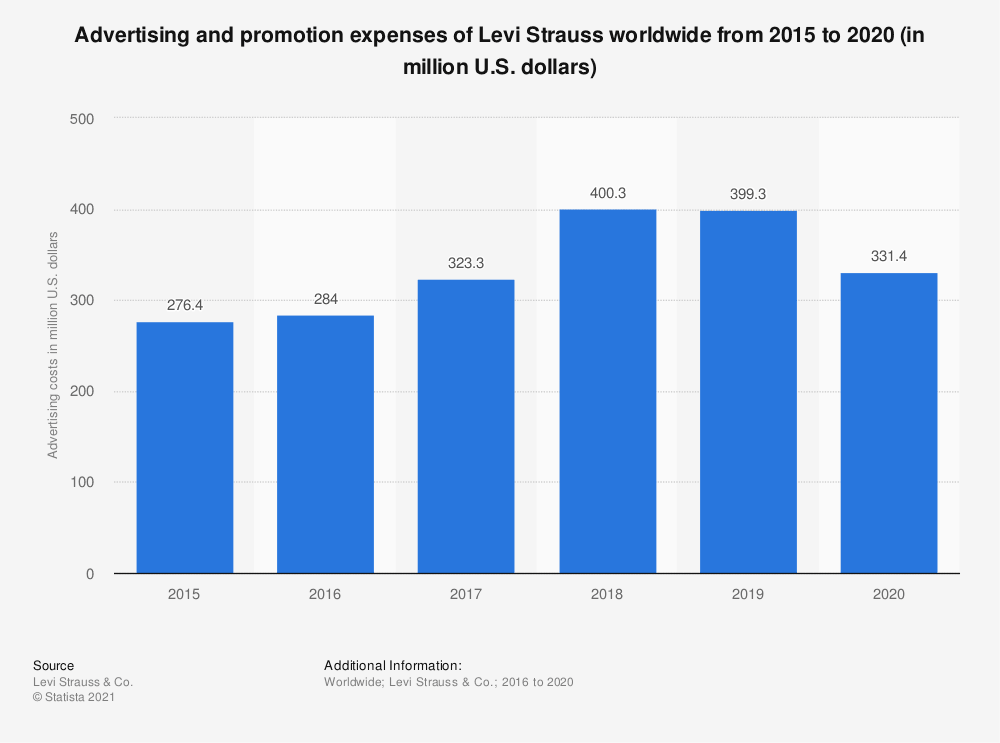Part
01
of two
Part
01
Marketing Strategies - Lee Jeans
Key Takeaways:
- Lee Jeans' marketing mix includes digital, television, influencer, and out-of-home advertising.
- Since 2019, digital advertising has been Lee Jeans' main advertising strategy and consumes the largest portion of its advertising budget.
- Lee Jeans' marketing efforts target new younger consumers, especially in the 18-24-years demographic. The brand is also targeting premium buyers.
Introduction:
- This report provides insights into Lee Jeans' marketing strategy. It also identifies the target of the company's marketing efforts as well an overview of its social media presence. Finding the marketing spend for Lee Jeans proved difficult as the company does not publicly reveal this information. Regardless, the research team managed to triangulate the spending in 2018 and provide useful information on the marketing expenditure of its parent company in 2019, 2020, and 2021. Below is an overview of the findings, as well as an explanation of the methodology used.
Selected Findings
Lee Jeans Marketing Strategy
- In October 2021, Lee launched a digital-first marketing campaign dubbed Lee Originals to celebrate its dedication to denim and to promote consumers' individual styles. The campaign was launched on YouTube as well as streaming and digital channels. It was also featured on Lee Jeans' e-commerce website and social media channels.
- The brand also tapped a broad array of influencers ranging from famous progeny to activists and athletes for this campaign. It included commentary from Levi Dylan (model and Bob Dylan's grandson), Kenya Kinski-Jones (model and Quincy Jones' and Nastassja Kinski's daughter), Quannah Chasinghorse (activist and indigenous model), Annahstasia Enuke (visual artist and singer-songwriter), and Haden McKenna (model and skateboarder). Each influencer was featured in a short video sharing their perspective on originality.
- The campaign also included a television spot named "Strut" that used Lenny Kravitz's song of the same name. The performers were styled by Arianne Phillips, a costume designer. Here is a link to the video on iSpot.
- Additionally, the Lee Originals campaign included out-of-home (OOH) placements in New York City's neighborhoods.
- This campaign is a reflection of Lee Jeans' announcement in 2019 that it would double its digital advertising efforts at the expense of traditional media advertising. Its new approach also entailed working more with influencers. The increased digital budget was channeled towards digital buys and paid social.
Social Media Platforms
- Facebook: 1,682,515 likes and 1,638,540 followers.
- Instagram: 483,000 followers.
Target Market
- The use of famous progeny and the young age of the influencers and performers in the Lee Originals campaign indicates that Lee Jeans' marketing efforts are targeted at the younger generation of buyers. In fact, the brand's Global Brand President said that Lee was repositioning to attract new younger consumers.
- According to Sourcing Journal, the Lee Originals campaign garnered over "127 million digital media impressions" across live streaming and social platforms targeting 18-24-year-olds. The brand also aims to bring in premium clients as the denim trend is revived and shoppers continue to lean towards more casual styles.
Marketing Spend
- In 2018, Lee Jeans spent $11.2 million on media advertising. At the time, media advertising represented 60% of its total advertising spend, which means that the total advertising spend was = ($11.2 million X 100)/60 = $18.67 million. At 40% of the total spend, digital advertising cost about $7.47 million in 2018.
- In 2019, the company's digital spending accounted for 80% of its marketing budget. The remaining 20% went to traditional media advertising. This is the latest available breakdown of its marketing budget, although MediaRadar reports that the company spent less than $100 million on advertising in the past year, which was not helpful in estimating its expenditure.
- Kontoor Brands, Inc., the owner of Lee Jeans and Wrangler, provides its annual marketing spend but does not offer a breakdown by brand. In 2019, 2020, and 2021, the company spent $119.3 million, $98.8 million, and $142.0 million in total, respectively.
Research Strategy
To provide insights into the marketing strategy of Lee Jeans, the research team analyzed the strategies employed in its latest marketing campaign. An older source also provided information on the company's marketing evolution as of 2019. The research team also provided the numbers on its social media platforms. An analysis of the company's marketing campaign in 2021 as well as sentiments from its leadership shed light on the target of its marketing efforts. Finding the marketing spend for Lee Jeans proved difficult as the company does not publicly reveal this information. For this, the research team searched through the public domain for any data provided from media resources, marketing industry-focused resources such as Adweek, Adage, and Media Radar. We also looked for any statistics provided by sites such as Statista, but this only provided 2014 figures. The last time Lee's executives revealed information on its marketing spend was in 2019 when they announced the shift of advertising focus from traditional media marketing to digital advertising. Next, the research team searched through its financial reports, especially annual reports. However, the reports are published by its parent company, Kontoor Brands, Inc., which provides its annual marketing spend but does not offer a breakdown by brand.


